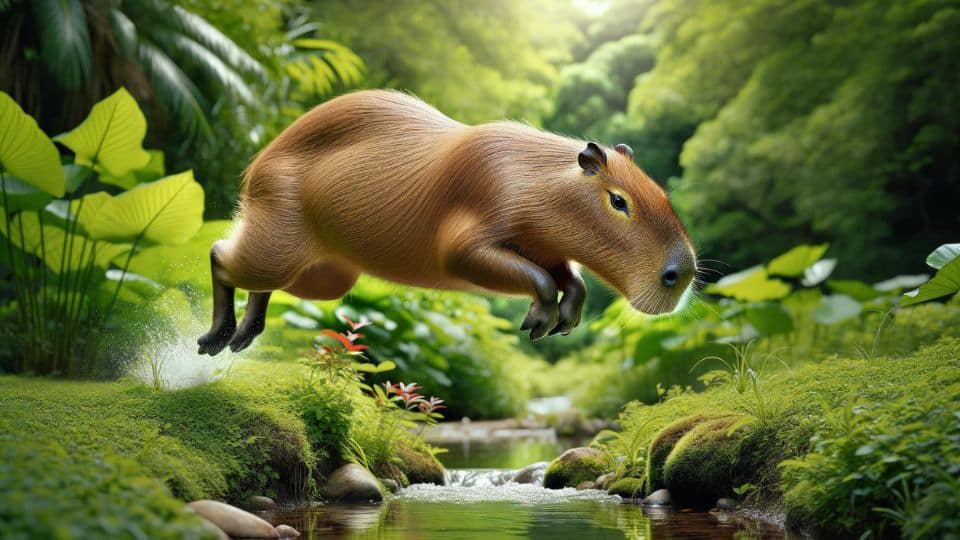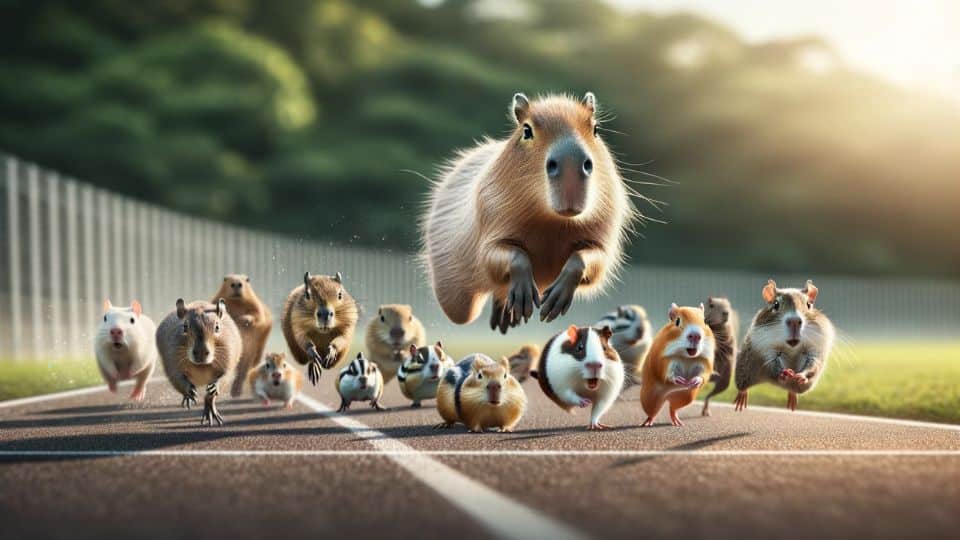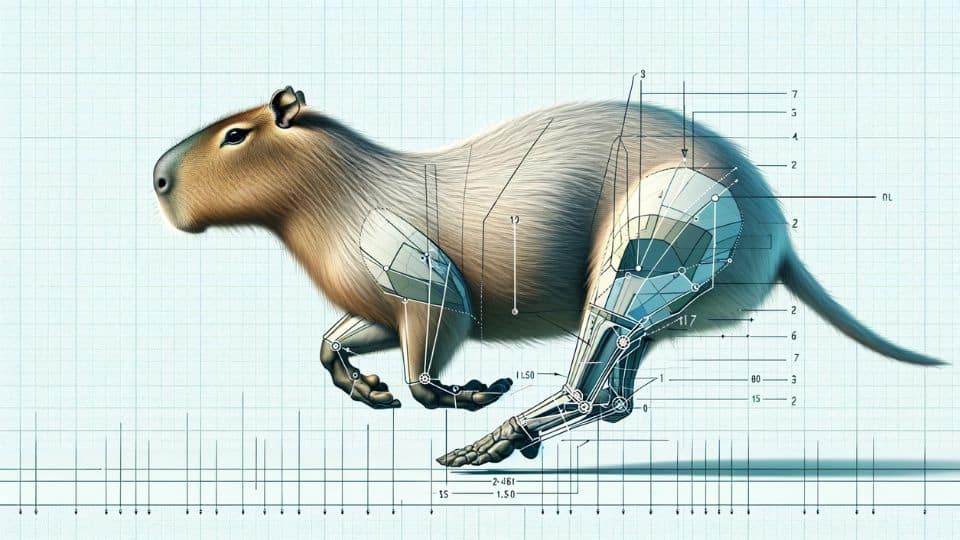Capybaras, the world’s largest rodents, can reach impressive speeds of up to 35 kilometers per hour (22 miles per hour). Despite their size, they exhibit remarkable agility and endurance, making them surprisingly swift on land. This speed is essential for their survival in the wild, aiding in escaping predators.
A Blend of Agility and Power

Agility and Maneuverability: Not only are capybaras fast, but they are also extremely agile. This agility aids them in evading predators, making sharp turns and sudden stops while running. Their strong claws and webbed feet enhance their grip, making them excellent climbers and swimmers as well.
Anatomy for Speed: The capybara’s anatomy is a key factor in its ability to run fast. They possess short, muscular legs covered in thick fur, a large, muscular chest, and hindquarters. Their wide, webbed feet aid in swimming, while their long, flattened tails provide balance during running and act as a rudder in water.
Survival Tactics: Capybaras use their speed primarily for survival. They can escape predators by reaching speeds of up to 10 mph, which they can sustain for up to 3 minutes. This speed, combined with their agility, makes them difficult targets for predators.
Average Speed: On average, capybaras can run up to six miles per hour over short distances. It’s important to note that this average speed, while not as high as their top speed, is still notable given their large size and different mode of locomotion compared to other animals. While this article focuses on the terrestrial speed of capybaras, their aquatic abilities are equally impressive.
Utilizing Speed for Daily Life: Capybaras leverage their speed for various daily activities, including escaping predators and finding food. They are capable of covering more ground faster when searching for food, and their agility helps them access food sources quickly and evade potential dangers.
The agility and speed of capybaras, essential for evading predators, are remarkable traits for an animal that spends much of its time grazing on grasses and aquatic vegetation.
Comparison of Capybaras with Other Rodents

Capybaras are unique in the rodent family, not just for their size but also for their speed. Here’s how they compare to other well-known rodents:
Brown Rat
Average Speed: 8 kph (5 mph)
Characteristics: Known for their quick, darting movements, brown rats are agile but not as fast as capybaras.
Squirrel
Average Speed: 20 kph (12 mph)
Characteristics: Squirrels are agile both in trees and on the ground, with quick movements that help them evade predators.
Guinea Pig
Average Speed: 9 kph (5.5 mph)
Characteristics: While not known for speed, guinea pigs can sprint short distances, but they are slower than capybaras.
Beaver
Average Speed: 6 kph (3.7 mph)
Characteristics: Beavers are more adept in water than on land, and their speed on land is considerably slower than that of capybaras.
Chipmunk
Average Speed: 21 kph (13 mph)
Characteristics: Chipmunks exhibit very agile and quick movements, with bursts of speed that are impressive for their size.
Hamster
Average Speed: 6 kph (3.7 mph)Characteristics: Hamsters are capable of quick movements, especially in their burrows, but their overall speed is less than that of capybaras.
Remember! A capybara confined to a small space may become stressed or develop health issues, so space for running and exercise is not just a luxury, but a necessity for these swift and active creatures.
How do capybaras run?

Physical Attributes Influencing Their Run
Sturdy Legs: Capybaras have short but sturdy legs that provide stability and strength. This is essential for supporting their large bodies during fast movements.
Webbed Feet: Their partially webbed feet are not only useful for swimming but also aid in running, especially on soft or muddy ground, which is common in their natural habitats near water bodies.
Low Center of Gravity: Their body structure, with a significant bulk concentrated closer to the ground, gives them a low center of gravity. This helps in maintaining balance while running and making quick turns.
Running Mechanics
Gait: Capybaras typically use a galloping gait when running at high speeds. This gait involves a sequence where all four feet leave the ground, allowing for brief moments of airborne travel, which contributes to their speed.
Speed and Agility: Despite their size, capybaras can reach speeds up to 35 kph (22 mph). They are surprisingly agile, capable of making sharp turns and sudden stops, which is crucial for evading predators.
Endurance: Capybaras can sustain their running speed for several minutes, which is an important survival trait in the wild, especially when escaping from predators.
Adaptation to Environment
Swamp and Wetland Navigation: In their natural habitats, which often include swamps, marshes, and riverbanks, capybaras are adept at moving quickly through both water and muddy terrain.
Escape Tactics: When threatened, capybaras can quickly transition from running to swimming, using their speed and agility to evade predators in both environments.
While it might be difficult to imagine such a large rodent moving quickly, the capybara’s speed is an essential aspect of their interaction with their environment, particularly when they need to evade natural predators. Capybaras can outrun some predators, but can they legally run in your backyard in Virginia? Learn about capybara ownership in Virginia.
Do capybara like running around or chilling?

Capybaras, known for their calm and sociable nature, generally prefer a more relaxed and leisurely lifestyle. Here’s a look at their behavior in terms of activity and relaxation:
Preference for Relaxation
Socializing and Resting: Capybaras are highly social animals and often spend a significant amount of time lounging and socializing with their group. They are frequently observed resting near water bodies or on the banks of rivers and lakes.
Sunbathing and Water Soaking: They enjoy sunbathing and often soak in water to regulate their body temperature and relax. This behavior is particularly common in the hot midday sun.
Gentle Disposition: Known for their gentle and placid disposition, capybaras are not typically very playful or overly active. They exhibit a calm demeanor that aligns more with chilling than with energetic activities. Explore more about their physical capabilities, including speed, in our detailed capybara facts.
Activity and Movement
Swimming: While they might not be fond of running around excessively, capybaras are excellent swimmers and spend a lot of time in the water. Swimming is a preferred activity, and they are well-adapted for an aquatic lifestyle.
Foraging: Capybaras are most active during the early morning and in the evening when they forage for food. This activity involves walking around and occasionally swimming to different locations to feed on grasses and aquatic plants.
Running as a Necessity: Running is generally reserved for escaping predators or when startled. While they can run fast, it’s not an activity they engage in for enjoyment or play.
The physical attributes that contribute to a capybara’s speed are just part of what makes them remarkable. Their overall size and demeanor have also led to a special affection for them, inspiring the nickname ‘gentle giant babies‘ within the animal community. Here are 200+ names that you can name your capybara pet.
Wrap Up
When considering a capybara as a pet, it’s important to factor in their need for running and physical activity. These animals are naturally built for speed and require ample space to exercise. If you’re planning to keep a capybara, ensure you have a large, safe area where they can run freely and express their natural behavior.
This space should ideally mimic their natural habitat, with room for both land and water activities. Regular exercise is crucial for their physical health and mental well-being, so providing an environment where they can move around at their natural pace is key to a happy capybara.



